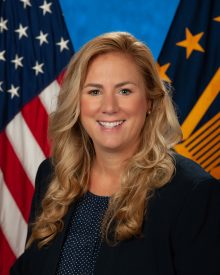WASHINGTON — As leaders from across multiple federal agencies begin work on a roadmap to combat veteran suicide, they are searching for ways to turn existing efforts in towns, cities, counties and neighborhoods across the country into a net that can help catch struggling veterans.
While veteran suicide might be a national crisis, its most promising solutions will likely be found at community-level organizations—outside of VA, agency leaders told Congress last month. What remains unclear is if those local organizations, especially non-VA healthcare providers, are fully trained and ready to provide the level of care these veterans need.
“Two days ago, I chaired the inaugural meeting of the President’s Task Force on Veterans’ Suicide, which is charged with developing a roadmap to combat this tragedy,” VA Secretary Robert Wilkie told the Senate VA Committee. “Our goal is to create a template to show how government at all levels, NGOs and others, can work together. It will take into account a whole-of-government approach that’s been lacking, bringing together VA, DoD, HHS, NIH and HUD to address the many factors that contribute to suicide.”
This inaugural meeting came on the heels of the implementation of the VA MISSION Act, which expands veterans’ ability to seek care from non-VA providers. This includes community-based mental healthcare providers. However, previous studies have shown that few meet VA’s criteria for providing comprehensive care.
A 2013 RAND study found that only 13% of community providers nationwide met VA’s readiness criteria for treating veterans for mental health conditions. Last year, a new study limited to New York State found only 2% met all the criteria.
Wilkie assured legislators that VA would not include providers in its community care networks who were not prepared to treat veterans’ needs. “We are still actively vetting,” he said. “We are not sending a veteran out into the field without knowing where he or she is going.”
Considering the small percentage RAND found to meet VA standards, it’s likely that providers will require assistance meeting VA’s criteria.
“The goal of our task force is not only to have the best standards, but to make sure community providers meet those standards,” Wilkie said.
One way VA hopes to do this is through grants to local organizations providing mental healthcare. Originally suggested by the White House, the idea has now been rolled into The Commander John Scott Hannon Veterans Mental Health Care Improvement Act—legislation currently under consideration by Congress. Among its many provisions, the bill calls for $5 million in grants to be made available in 2021, $10 million in 2022 and $15 million in 2023.
The grants, Wilkie said, “would get money and resources to the states, localities, NGOs and tribal governments closest to the problem.”
In lieu of such grants, VA is working with other organizations to help improve mental health training for non-VA providers.
“The importance of training providers on evidence-based practices and cultural competency is critically important,” explained Keita Franklin, PhD, LCSW, VA’s National Director of Suicide Prevention “We have a partnership with [the nonprofit organization] PsychArmor, who have taken it on themselves to train mental health providers across the nation in how to interact with veterans.”
Such partnerships will be key going forward, Franklin declared, and a push will be needed to have credentialing organizations such as the National Association of Social Workers and American Psychiatric Association add veteran-specific components to their training.
VA leaders stressed that, while comprehensive mental healthcare is imperative, it is not a silver bullet and that, if a veteran reaches a point of attempting suicide, that means there have been a number of missed opportunities to assist them.
“If we only look at the last tragic events in a veteran’s life, we will never get our arms around what we need to prevent this tragedy,” Wilkie declared. “[We must have] a national conversation. Not just about the final act of suicide, but about factors leading up to that sad day—mental health, substance abuse and homelessness. We must have a conversation about the totality of life in America.”
Part of that conversation includes access to firearms, a topic senators pressed Wilkie on at the hearing. Specifically, they asked how VA would incorporate restrictions to gun access into its strategy. Wilkie was careful to avoid the topic of gun ownership but stressed that VA would continue its work promoting gun safety.
“Approximately 70% of veterans who take their lives do so with firearms. We are dealing with a culture who have a special familiarity with firearms,” Wilkie said. “Our goal here is to build into a veteran’s lifetime and space between the thought [of suicide] and the act.”
VA hopes to provide that time and space by providing gun safety education programs and giving out gun locks. However, senators seemed unsatisfied with this response, and asked for Wilkie to create a working group or task force specifically tasked with gun violence prevention as it relates to suicide.
This message that VA must look beyond the realm of mental healthcare to combat veteran suicide is one that’s been spearheaded by Franklin during her nearly two years as VA’s National Director of Suicide Prevention. However, it was announced last month that she’ll be stepping down from the post. It’s been reported that current Veterans Crisis Line Director Matt Miller will fill the role until a new director is named.

